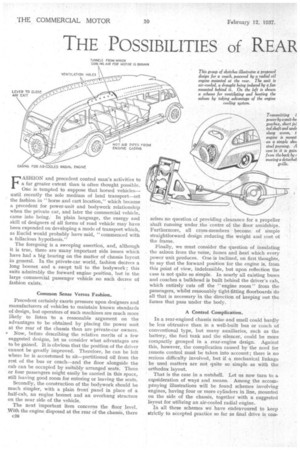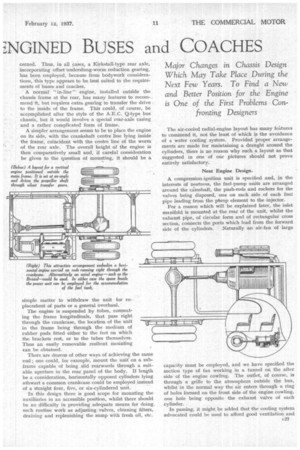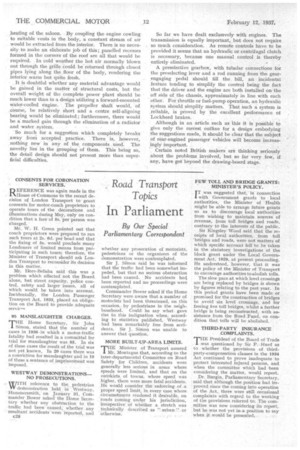THE POSSIBILITIES of REAR NGINED BUSES and COACHES F ASHTON and
Page 76

Page 77

Page 78

If you've noticed an error in this article please click here to report it so we can fix it.
precedent control man's activities to a far greater extent than is often thought possible. One is tempted to suppose that horsed vehicles— until recently the sole medium of land transport—set the fashion in "horse and cart location," which became a precedent for power-unit and bodywork relationship when the private car, and later the commercial vehicle, came into being. In plain language, the energy and skill of designers of all forms of road vehicle may have been expended on developing a mode of transport which, as Euclid would probably have said, "commenced with a fallacious hypothesis."
The foregoing is a sweeping assertion, and, although it is true, there are many important side issues which have had a big bearing on the matter of chassis layout in general. In the private-car world, fashion decrees a long bonnet and a swept tail to the bodywork ; this suits adniirably the forward engine position, but in the large commercial passenger vehicle no shell decree of fashion exists.
Common Sense Versus Fashion.
Precedent certainly exerts pressure upon designers and manufacturers of vehicles to maintain known standards of design, but operators of such machines are much more likely to listen to a reasonable argument on the advantages to be obtained by placing the power unit at the rear of the chassis than are private-car owners.
• Now, before describing the relative merits of a few suggested designs, let us consider what advantages are to be gained. It is obvious that the position of the driver cannot be .greatly improved. Therefore, he can be kit where he is accustomed to sit—partitioned oil from the rest of the bus or coach—and the floor alongside the cab can be occupied by suitably arranged seats. Three or four passengers might easily be carried in this space, still leaving good room for entering or leaving the seats.
Secondly, the construction of the bodywork should be much simpler, with a plain front panel in place of a half-cab, an engine bonnet and an overhung structure on the near side of the vehicle.
The next important item concerns the floor level. With the engine disposed at the rear of the chassis, there c26
arises no question of providing clearance for a propeller shaft running under the centreof the floor amidships. Furthermore, all cross-members become of simple straightforward design reducing the weight and cost of the frame.
Finally, we must consider the question of insulating the saloon from the noise, fumes and heat which every power unit produces. One is inclined, on first thoughts, to say that the forward position for the engine is, from this point of view, indefensible, but upon reflection the case is not quite so simple. In nearly all existing buses and coaches a bulkhead is built behind the driver's cab, which entirely cuts off the "engine room" from the passengers, whilst reasonably tight-fitting floorboards do all that is necessary in the direction of keeping out the fumes that pass under the body.
A Control Complication.
In a rear-engined chassis noise and smell could hardly be less obtrusive than in a well-built bus or coach of conventional type, but many auxiliaries, such as the battery, the fuel tank and the silencer, could be more compactly grouped in a rear-engine design. Against this, however, the complication caused by the need for remote control must be taken into account ; there is no serious difficulty involved, but if a mechanical linkage be used matters are not quite so simple as with the orthodox layout.
That is the case in a nutshell. Let us now turn to a comideration of ways and means. Among the accompanying illustrations will be found schemes involving engines, having four or more cylinders in line, mounted on the side of the chassis, together with a suggested layout for utilizing an air-cooled radial engine.
In all these schemes we have endeavoured to keep strictly to accepted practice so far as final drive is con cerned. Thus, in all cases, a Kirkstall-type rear axle, incorporating offset underslung-worm reduction gearing, has been employed, because from bodywork considerations, this type appears to be best suited to the requirements of buses and coaches.
A normal "in-line" engine, installed outside the chassis frame at the rear, has many features to recommend it, but requires extra gearing to transfer the drive to the inside of the frame. This could, of course, be • accomplished after the style of the A.E.C. Q-type bus chassis, but it would involve a special rear-axle casing and a rather complicated form of frame.
A simpler arrangement seems to be to place the engine on its side, with the crankshaft centre line lying inside the frame, coincident with the centre line of the worm • of the rear axle. The overall height of the engine is then comparatively small and, if careful consideration be given to the question of mounting, it should be a simple matter to withdraw the unit for replacenlent of parts or a general overhaul.
The engine is suspended by tubes, connecting the frame longitudinals, that pass right through the crankcase, the location of the unit in the frame being through the medium of rubber pads fitted either to the feet on which the brackets rest, or to the tubes themselves. Thus an easily removable resilient mounting can be obtained.
There are dozens of other ways of achieving the same end ; one could, for example, mount the unit on a subframe capable of being slid rearwards through a suitable aperture in the rear panel of the body. If length be a consideration, horizontally opposed cylinders lying athwart a common crankcase could be employed instead of a straight four, five, or six-cylindered unit.
In this design there is good scope for mounting the auxiliaries in an accessible position, whilst there should be no difficulty in providing adequate means for doing such routine work as adjusting valves, cleaning filters, draining and replenishing the sump with fresh oil, etc. The air-cooled radial-engine layout has many features to commend it, not the least of which is the avoidance of a water cooling system. Provided proper arrangements are made for maintaining a draught around the cylinders, there is no reason why such a layout as that suggested in one of our pictures should not prove entirely satisfactory.
Neat Engine Design.
A compression-ignition unit is specified and, in the interests of neatness, the fuel-pump units are arranged around the camshaft, the push-rods and rockers for the valves being disposed, one on each side of each fuel pipe leading from the ptimp element to the injector.
For a reason which will be explained later, the inlet manifold is mounted at the rear of the unit, whilst the exhaust pipe, of circular form and of rectangular cross section, connects the ports which lead from the forward side of the cylinders. Naturally an air-fan of large capacity must be employed, and we have specified the suction type of fan working in a tunnel on the after side of the engine cowling. The outlet, of course, is through a grille to the atmosphere outside the bus, whilst in the normal way the air enters through a ring of holes formed on the front side of the engine cowling, one hole being opposite the exhaust valve of each cylinder.
In passing, it might be added that the cooling system advocated could be used to afford good ventilation and c27
heating of the saloon. By coupling the engine cowling to suitable vents in the body, a constant stream of air would be extracted from the interior. There is no necessity to make an elaborate job of this ; panelled recesses formed in the corners of the roof are all that would be required. In cold weather the hot air normally blown out through the grille could be-returned through closed pipes lying along the floor of the body, rendering the interior warm but quite fresh.
It is doubtful whether any material advantage would be gained in the matter of structural costs, but the overall weight of the complete power plant should be much lower than in a design utilizing a forward-mounted water-cooled engine. The propeller shaft would, of cOurse, be relatively short and a centre self-aligning bearing would be eliminated ; furthermore, there would be a marked gain through the elimination of a radiator and -water system.
So much for a suggestion which completely breaks away from accepted practice. There is, . however, nothing new in any of the components used. The novelty lies in the grouping of them. This being so, the detail design should not present more than superficial difficulties. So far we have dealt exclusively with engines. The transmission is equally important, but does not require so much consideration. As remote controls have to be provided it seems that an hydraulic or centrifugal clutch is necessary, because one manual control is thereby entirely eliminated. • A preselective gearbox, with tubular connections for the preselecting lever and a rod running from the gearengaging pedal should fill the bill, an incidental feature tending to simplify the control being the fact that the driver and the engine are both installed on the off side of the chassis, approximately in line with each other. For throttle or fuel-pump operation, an hydraulic system should simplify matters. That such a system is reliable, is proved by the excellent performance of Lockheed brakes.
Although in an article, such as this it is possible to give only the merest outline for a design embodying the suggestions made, it should be dear that the subject of rear-engined passenger vehicles will become increasingly' important. Certain noted British makers are thinking seriously about the problems involved, but so far very few, if any, have got beyond the drawing-board stage.




























































































































































